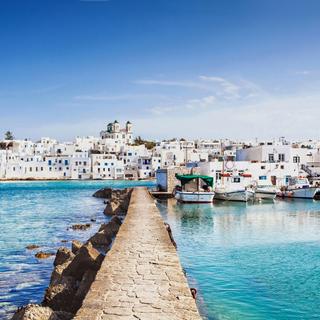
Mykonos weather and climate in 2025

Mykonos weather and climate in 2025
Day
29 °C
Night
23 °C
Sea
23 °C
Precipitation
2 mm
in month
Rainy days
0 days
in month
Daylight
13 hours
average
Sunshine
13 hours
average
Humidity
66 %
Weather charts for Mykonos
Destinations nearby and activities
Destinations nearby
Activities in Mykonos

Find more destinations like this
Destinations with similar weather to Mykonos
Other destinations in Aegean Sea - Greece
Closest cities for Mykonos
Last week's weather in Mykonos
During the week of 30 June 2025 - 6 July 2025, temperatures averaged at 27 °C (81 °F) during the day and dropped to 22 °C (72 °F) at night. Both the daily and night temperatures in Mykonos are roughly same as the long-term average, which is around 28 °C (82 °F) and 22 °C (72 °F) respectively. The beginning of the week saw Tuesday being the hottest day of the week. The average temperatures observed during different times of day (based on local time) were as below: 7am 22 °C (72 °F), 10am 25 °C (77 °F), 1pm 27 °C (81 °F), 4pm 27 °C (81 °F), 7pm 26 °C (79 °F), 10pm 25 °C (77 °F).
There were 7 days without rain during this week. Mykonos received 0 mm (0.00 in) of precipitation throughout the week, which is roughly same as its long-term average of 1 mm (0.04 in). During the daytime (from dawn to dusk), there was 0 % cloud coverage on average.
The wind's speed averaged 9.1 m/s. The most common wind direction(s) was North. The air pressure varied between 1008 hpa and 1015 hpa. The average air humidity was 52 % in Mykonos.
During the daytime (from dawn to dusk), there were in average: 16 hours clear skies. At 06:01, on average, the sun rose, and at 20:43, the sun set.
Weather overview for Mykonos
Weather overview
Mykonos, a stunning island located in Greece, is renowned for its warm and pleasant climate. Over the course of the year, daytime temperatures range between an average low of 14 °C (57 °F) during the cooler month of February and an average high of 29 °C (84 °F) in the warmest month of August. January is the month that sees the most rainfall, with an average of 8 days, while August is the driest, averaging a mere 0 days of rain. Sea temperatures also vary, reaching a chilly 15 °C (60 °F) in March and warming up to a comfortable 23 °C (74 °F) by August. The most sultry night-time temperatures occur in July, averaging 23 °C (74 °F), while February has the coolest nights, averaging just 9 °C (47 °F).
January weather
In January, the daytime temperature in Mykonos steadily declines to 14 °C (57 °F), while the sea temperature also decreases to 16 °C (60 °F). The peak of the rainy season can be observed, with the number of clear sky hours reaching a minimal value. There is a notable drop in the nighttime temperature, averaging 9 °C (49 °F).
February weather
February in Mykonos marks the start of a decrease in rainfall. The coldest daytime temperature of the year is noted, averaging 14 °C (57 °F), and the nighttime temperatures reach their yearly low, averaging 9 °C (47 °F). An increase in the number of clear sky hours begins, averaging 5 hours, and February experiences the maximum wind speed.
March weather
March sees the onset of rising daytime temperatures in Mykonos, averaging 16 °C (61 °F), while the sea temperature remains at its yearly low. The reduction in rainfall continues, with an average of 51 mm (2.02 in), and there is a beginning of a decline in the number of rainy days, averaging 6 days. The nighttime temperature begins to increase to 10 °C (50 °F), and the duration of clear skies extends with an average of 7 hours.
April weather
With the advent of April, day temperatures in Mykonos continue to rise, averaging 19 °C (67 °F). There is a noticeable increase in the sea temperature. The descent in the number of rainy days is evident, and the rainfall quantity continues to diminish, registering 23 mm (0.89 in). The nighttime temperature keeps climbing, marking 12 °C (54 °F), and the wind speed reaches its minimum for the year.
May weather
May in Mykonos is defined by an ascending day temperature pattern, listed at 24 °C (74 °F), and the sea temperature also exhibits a rising trend. The rainfall quantity continues its previous downward trajectory, reaching 11 mm (0.44 in), and there is a persistent decline in the number of rainy days, noted as 2 days. The dry season becomes more pronounced, and night temperatures continue to augment, now averaging 16 °C (61 °F).
June weather
June's Mykonos climate is marked by rising daytime temperatures, averaging 28 °C (82 °F), and sea temperatures that similarly trend upward, averaging 21 °C (70 °F). The beginning of the tourist season is apparent. The continued decrease in the number of rainy days is registered, averaging 0 days, and there is a concurrent reduction in rainfall amounts, noted at 3 mm (0.13 in). The nighttime temperature also advances, reaching 21 °C (70 °F).
July weather
In July, Mykonos witnesses an upward trend in day temperatures, coupled with a continued ascent of sea temperatures at 23 °C (73 °F). The tourist season is in full swing, with the lowest rainfall registered this month. July also ushers in the warmest nighttime temperatures. The maximum number of sunshine hours is realized, averaging 14 hours.
August weather
August signifies the peak of Mykonos's day temperatures, recorded at 29 °C (84 °F), and a peak in the sea temperature is also evident, listed at 23 °C (74 °F). The lowest incidence of rainy days is recognized, averaging only 0 days. Buoyant tourist activity continues, and a downward adjustment in the number of clear sky hours is observed, settled at 13 hours.
September weather
September in Mykonos is characterized by a commencing decline in daytime temperatures, now 26 °C (80 °F), and a similar declining movement of sea temperatures, 23 °C (73 °F). The rise in the number of rainy days is subtle, averaging 1 day. The onset of night temperature decrease is also notable, averaging 20 °C (69 °F). As the sun hours dwindle, averaging 11 hours, the tourist season remains at a peak.
October weather
October's dynamics in Mykonos show a continued reduction in day temperatures, noted at 23 °C (74 °F), with a parallel decrease in sea temperatures, registering 21 °C (69 °F). The ascending trajectory of rainy days persists, settled at 3 days, and there's an accompanying increase in rainfall tallies, averaging 33 mm (1.29 in). The dry season pauses as the night temperature keeps heading down, documented at 17 °C (62 °F).
November weather
The descent of daytime temperatures becomes more evident in November in Mykonos, averaging 18 °C (65 °F), while the sea temperature also heads downward, to 18 °C (65 °F). The increased count of rainy days follows the prior month's pattern, reaching 6 days, and a rise in the total rainfall quantity is detectable, at 63 mm (2.47 in). The relative humidity peaks, averaging 73 %. The continuing decline in night temperatures is appreciated, at 13 °C (56 °F).
December weather
December in Mykonos is marked by the continued drop in sea temperature, registered at 16 °C (62 °F), as well as the ongoing descent in daytime temperature, now at 15 °C (60 °F). The uptick in rainy days advances, notching an increase to 8 days, and the highest rainfall of the year is reported this month. The drop in night temperature is also present, recorded at 11 °C (51 °F). The shortest daylight hours are evident, averaging 9 hours.
FAQs
What trend can be seen in weather conditions throughout January in Mykonos?
January in Mykonos is marked by a decline in both day and sea temperatures, while the maximum number of rainy days is reported, along with the lowest number of sunshine hours.
How does the weather change in February in Mykonos?
As February arrives, there's a noticeable reduction in rainfall in Mykonos along with the chilly day and night temperatures reaching their lowest points for the year. One can observe a slight increase in sunlight hours as the island experiences its highest winds.
What changes in the March weather can be expected in Mykonos?
Expect a gradual increase in March's daytime temperature in Mykonos, while the sea remains relatively cool. Rainfall lightly decreases, and you can enjoy a slight rise in both nighttime temperature and hours of sunshine.
Describe the April climate in Mykonos?
April in Mykonos is characterized by a continued increase in day temperatures and an initial rise in sea temperatures, combined with fewer rainy days and scanty rainfall, while night temperatures gently rise and wind speeds settle to their lowest.
How do day and night temperatures differ in May in Mykonos?
Throughout May in Mykonos, you'll encounter a noticeable difference with warmer daytime temperatures averaging 24 °C (74 °F), while nighttime temperatures offer a milder experience, maintaining an average of 16 °C (61 °F).
What can guests anticipate in terms of June's weather in Mykonos?
Guests visiting Mykonos in June can enjoy the increasing heat of daytime temperatures and warmer seas, with minimal chances of rain. Tourist season kicks off under skies that remain clear more often, as nights stay comfortably warm.
What is one of the peak characteristics of Mykonos' climate in July?
July is noted for the peak of daylight temperatures and the height of the tourist season. The sea temperature is ideal for swimming, and the provision of longest daylight hours mirrors the island's summer spirit.
How does the climate in Mykonos peak during August?
In the zenith of summer, August in Mykonos delights with the highest day and sea temperatures, exceptionally dry conditions, and enduring tourist enthusiasm set against a backdrop of lengthy summer days.
What is the weather pattern observed in September in Mykonos?
As summer wanes in September, visitors to Mykonos will notice the daytime and sea temperatures starting to cool, while the invitation to enjoy the island's offerings remains strong amid a slight uptick in rainy days.
Does October in Mykonos witness a significant weather shift?
October ushers in a more noticeable shift in Mykonos' climate with a progressive cool-off in both day and sea temperatures, paralleled by increasing rainfall as the island transitions away from the dry season.
Can one expect a continuation of the dry season during November in Mykonos?
November breaks away from the dry season in Mykonos with greater frequency of rainy days, swelling rainfall, rising humidity, and an ongoing dip in both daytime and nighttime temperatures.
How does weather tend to evolve in December in Mykonos?
Winter creeps into December in Mykonos as temperatures continue to fall, both in the sea and in the air, and rain becomes more common, fitting for the month with the shortest days of the year.











